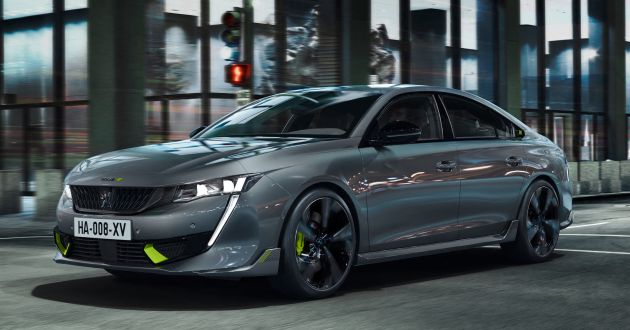Peugeot 508 PSE sedan, wagon unveiled – 360 hp/520 Nm dual-motor PHEV; 2.03 L/100 km, 0-100 km/h 5.2s
Peugeot has premiered the 508 PSE, the high-performance dual-motor plug-in hybrid version of its 508 in sedan and SW estate bodystyles. This is the ‘quintessential expression’ of Peugeot Sport engineers’ expertise, says the firm, and here appear to rather closely resemble the 508 Peugeot Sport Engineered Concept that was unveiled at last year’s Geneva Motor Show.
Touted as Peugeot’s most powerful production model to date, powertrain for the 508 PSE is comprised of a 1.6 litre inline-four cylinder direct-injection turbocharged petrol engine that produces 200 PS at 6,000 rpm and 300 Nm of torque at 3,000 rpm, and this is mated to a pair of electric motors; the front axle motor produces 110 hp and 320 Nm of torque, while the rear unit makes 113 hp and 166 Nm of torque.
Total system output is 360 hp and 520 Nm of torque sent to all four wheels, with an eight-speed automatic gearbox handling transmission duty on the front axle. Thus equipped, the 508 PSE does the 0-100 km/h sprint in 5.2 seconds, 80-120 km/h in 3.0 seconds and the standing kilometre sprint in 24.5 seconds. Top speed with full use of the powertrain’s outputs is 250 km/h, or 140 km/h in electric mode.


The 11.5 kWh lithium-ion battery in the 508 PSE will take less than seven hours to reach a full charge from a standard domestic power outlet, or four hours from a 16-amp reinforced socket. The quickest recharging is done via a 32-amp wall box, which will fully recharge the battery pack in under two hours, says Peugeot.
For reference, the 300 hp 508 and 508 SW Hybrid use a Type 2 connector, and those are rated for a four-hour charge time from a 3.3 kW 14-amp outlet, while an optional 6.6 kW 32-amp three-phase wallbox charger does a full charge in under one hour 45 minutes. The hybrid battery and drive systems do not encroach upon cabin space in both 508 PSE sedan and wagon versions, says Peugeot.
Chassis upgrades over the regular Peugeot 508 range include adaptive damping with Comfort, Hybrid and Sport modes, a lowered seat plate as well as front and rear tracks widened by 24 mm and 12 mm respectively, four-piston front brake calipers on 380 mm brake discs, and Michelin Pilot Sport 4S tyres on 20-inch wheels.
The Peugeot 508 PSE offers five drive modes – Electric, Comfort, Hybrid, Sport and 4WD – that control powertrain and chassis settings. Electric mode offers purely battery-powered driving up to 140 km/h, and has a battery-only range of 42 km. Combined fuel consumption is rated at 2.03 l/100 km according to WLTP testing protocol.


Comfort is a hybrid mode with softened suspension settings for maximum comfort, Hybrid selects powertrain usage automatically for optimised fuel consumption, and Sport summons the full output of the hybrid powertrain and sharpens the throttle map, while steering and damping settings are altered as well.
The powertrain is set to ensure the internal combustion engine keeps the battery fully charged for maximum output at all times, and the 4WD mode aids traction in slippery conditions. Inside, the 508 PSE adopts the French manufacturer’s i-Cockpit layout with a steering wheel that is given the Kryptonite (lime green) claw motif and Peugeot Sport Engineered branding. Audio comes courtesy of a Focal Audio system as standard.
Meanwhile, the graphic animations for the driver’s instrumentation and the 10-inch HD infotainment screen also get PSE labelling to set the high-performance sedan and wagon apart from the more mainstream versions, and upholstery for the comfort-fit seats is a mix of leather, 3D-mesh and Alcantara, trimmed in Tramontane grey and Kryptonite stitching.
Manufactured in Mulhouse, France, the Peugeot 508 PSE sedan and SW wagon is available Perla Nera (black), pearl white and the PSE-exclusive Selenium Grey, and the order books for the hybrid duo will open mid-October this year.




















The post Peugeot 508 PSE sedan, wagon unveiled – 360 hp/520 Nm dual-motor PHEV; 2.03 L/100 km, 0-100 km/h 5.2s appeared first on Paul Tan's Automotive News.
from Paul Tan's Automotive News
Read The Rest:paultan...



Post a Comment